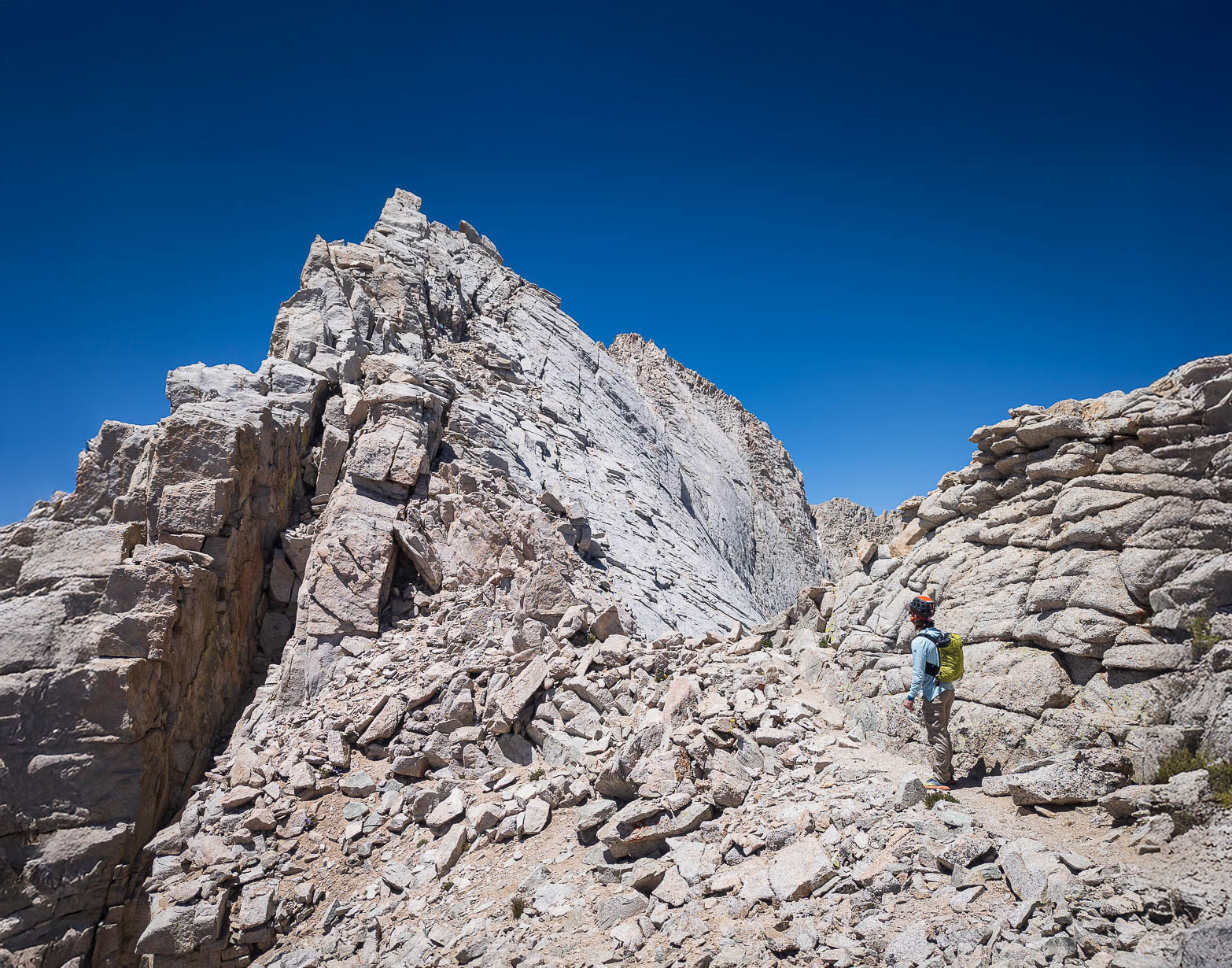
Whitney Portal.

Along the Mount Whitney Trail for a short time.

Junction along the Mount Whitney Trail, where we took the North Fork Lone Pine Creek Trail.

View back along the trail, which is easy to follow most of the time.

The North Fork Lone Pine Creek Trail gets tricky to follow as it crosses the brushy creek and approaches the Ebersbacher Ledges, seen ahead.

Ascending from the drainage up Class 2+ terrain to gain the Ebersbacher Ledges.

Navigating the Ebersbacher Ledges above the creek.

The Ebersbacher Ledges lead to higher ground above the drainage.

Ascending along the North Fork Lone Pine Creek Trail to Lower Boy Scout Lake.

Lower Boy Scout Lake just ahead. The trail crosses the creek and continues on the lake's south side. Mount Whitney's ridgeline is seen above.

The trail leads through a boulder field. Lower Boy Scout Lake seen below. Seen here is us off-route, but we managed to find the trail on the way back, reflected in my map/track.

Again the trail becomes a bit trickier to follow as it crosses the watercourse and ascends slabs of granite.

Ascending granite slabs, with a beautiful cascade rushing down as we enter the official Whitney Zone.

View back down the drainage.

Before reaching Upper Boy Scout Lake, we took a somewhat obvious social trail leading north toward the steep, sandy slope seen ahead.

Not a super fun ascend, but coming down later was excellent and quick.

View back down into the North Fork drainage as we make progress up the sandy slope.

Close-up back down at the annoying slog so far.

More progress up the sandy slope, as we near the rim.

Steeper still as we get higher.

At the rim, Mount Russell becomes visible (right of center).

Close-up of Mount Russell. It's a bit of a walk along a gradual slope.

Mount Whitney seen to the west.

Mount Whitney (left) and Mount Russell (right).

Approaching the east ridge.

Mount Russell east ridge, view toward Tulaino Lake.

View back from the east ridge along the slope we just hiked up (from the top left).

Starting up Mount Russell's east ridge. Class 2 for the first few hundred feet.

View back as the route becomes more interesting.

Approaching the famous scramble. The route leads above the steep dropoff, but just below the crest itself.

Along the ridge, just below the crest.

View back, the severe dropoff seen left. Tulaino Lake seen left.

A Class 3 move to get closer to the crest.

Just bouldery scramble moves along the crest for a while.

We only gained the crest for a few feet before it became sketchy, forcing us back just to the right.

Avoiding the jagged crest, traversing above the slick dropoff.

Wider shot of the ridgeline to come.

View back down.

Wider shot back.

A Class 3 move with exposure to overcome a flake.

A short section of ridgeline like this, followed by a slightly more complex section of Class 3.

The ridgeline continues to be jagged, but now the terrain to the right becomes blocky and exposed. Also to note: ahead in the center is a vertical crack. The route leads to the left of it and its adjacent rib (Class 2), though ascending to its right is Class 3/4.

Class 3 route-finding to pick the best route for 50 feet.

Ascending the Class 2 option mentioned earlier, view back along the ridgeline.

Summit of Mount Russell's east peak, continuing west.

View back toward the east peak.

Navigating some Class 2/3 ledges and blocks to traverse over to the high point.

Mount Russell summit ahead. We approached it by wrapping around on the right, Class 2/3.

Mount Russell summit, view west.

Mount Russell summit, view south toward Mount Whitney.

Mount Russell summit, view northwest.

Close-up northwest.
Hire me or show me some love!
Hire/refer me as a web developer or send me a few bucks if you find my site useful. I’m not sponsored, so all fees are out-of-pocket and my time preparing trip reports is unpaid. I really appreciate it!


